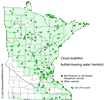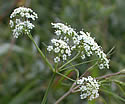Cicuta bulbifera (Bulblet-bearing Water Hemlock)
| Also known as: | |
|---|---|
| Genus: | Cicuta |
| Family: | Apiaceae (Carrot) |
| Life cycle: | perennial |
| Origin: | native |
| Habitat: | sun; swamps, fens, along shores, in slow moving water |
| Bloom season: | July - September |
| Plant height: | 1 to 4 feet |
| Wetland Indicator Status: | GP: OBL MW: OBL NCNE: OBL |
| MN county distribution (click map to enlarge): |  |
| National distribution (click map to enlarge): |  |
Pick an image for a larger view. See the glossary for icon descriptions.
Detailed Information
Flower: 

![[photo of flowers]](/udata/r9ndp23q/pd/cicuta-bulbifera-2-t.jpg) Flowers are in flat clusters (umbels) about 2 inches across arising from leaf axils and at the end of branching stems. Each cluster has about 15 groups (umbellets) of 1/8 inch flowers. Individual flowers have 5 notched white petals, a greenish center, and 5 stamens.
Flowers are in flat clusters (umbels) about 2 inches across arising from leaf axils and at the end of branching stems. Each cluster has about 15 groups (umbellets) of 1/8 inch flowers. Individual flowers have 5 notched white petals, a greenish center, and 5 stamens.
Leaves and stem: 

![[photo of leaves]](/udata/r9ndp23q/white/bulb-bearing-water-hemlock-0722_102910-t.jpg) Leaves are compound with 3 or more linear blade-like leaflets. Leaflets are up to 3 inches long, less than 1/8 inch wide, and have irregular, widely spaced teeth, or may be toothless. Stems are branched, hollow and hairless.
Leaves are compound with 3 or more linear blade-like leaflets. Leaflets are up to 3 inches long, less than 1/8 inch wide, and have irregular, widely spaced teeth, or may be toothless. Stems are branched, hollow and hairless.
Fruit: 
![[photo of bulblets]](/udata/r9ndp23q/white/bulb-bearing-water-hemlock-0813_162848-t.jpg) Viable seed may not be produced. Tiny bulblets (propagules) form in the leaf axils in the upper part of the plant, and is where this species gets its common name.
Viable seed may not be produced. Tiny bulblets (propagules) form in the leaf axils in the upper part of the plant, and is where this species gets its common name.
Notes:
This plant is deadly poisonous. The flat clusters of small white flowers is typical of members in the carrot family, but the leaves with fine, very narrow segments, and the spindly look of this plant distinguish it from related species such as Water Hemlock. The bulblets in the leaf axils are a distinguishing characteristic.
Native Plant Nurseries, Restoration and Landscaping Services ↓
More photos
 Bulblet-bearing Water Hemlock plant
Bulblet-bearing Water Hemlock plant Bulblet-bearing Water Hemlock in shallow water habitat
Bulblet-bearing Water Hemlock in shallow water habitat Bulblet-bearing Water Hemlock in a sedge meadow
Bulblet-bearing Water Hemlock in a sedge meadow
Photos by K. Chayka taken at Pioneer Park, Anoka County, and Sucker Lake, Ramsey County. Photos courtesy Peter M. Dziuk taken in Anoka and Polk counties.
Comments
Have you seen this plant in Minnesota, or have any other comments about it?
on: 2009-05-07 21:35:32
It came up along our shore of Hiner Pond once I killed the reed canary grass and hybrid cattails for a small restoration project. It's pretty in bloom, though someone from the Ramsey Conservation District thought I should get rid of it. What do you think?
on: 2009-05-08 07:10:37
It is a poisonous plant, so if there are little kids wandering around the area I'd consider getting rid of it.
on: 2020-08-04 09:08:56
Growing on the shoreline of Lake Margaret, Lake Shore.
on: 2022-09-30 17:00:53
There is a vigorous specimen of this plant growing beside the public water access at the Oak Leaf Lake unit of Swan Lake Wildlife Management Area a couple of miles west of St. Peter. The plant is dying back for the season, and is loaded with mature bulbils that are quite attractive, mostly of a blackish-purple color. I'll post photos elsewhere.






